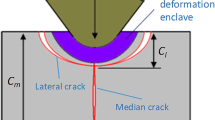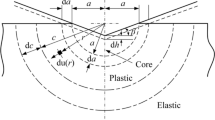Abstract
Ductile-regime machining is a promising technique for processing brittle materials. Although it has been widely investigated, there are few studies on the cutting force in the ductile-regime machining of brittle materials. This paper proposes a predictive cutting force model for ductile-regime machining of brittle materials, with an integration of the elastic recovery of the workpiece on the tool flank face and three parts of material removal on the tool rake face, i.e., the plowing effect, the plastic deformation, and the brittle fracture. Using the predictive cutting force model, it was found that the cutting force caused by the brittle fracture takes a dominant place in the total cutting force in the cutting process. Groove cutting experiments were carried out on the MgF2 (100) crystal to validate the predictive cutting force model. The measured cutting forces showed good agreement with the predicted cutting forces. In addition, it was found that the fluctuation of the measured cutting force increases with the increase of the cutting force caused by the brittle fracture.
Similar content being viewed by others
References
Heidari M, Yan J (2017) Ultraprecision surface flattening of porous silicon by diamond turning. Precis Eng 49:262–277. https://doi.org/10.1016/j.precisioneng.2017.02.015
Peng Y, Jiang T, Ehmann KF (2014) Research on single-point diamond fly-grooving of brittle materials. Int J Adv Manuf Technol 75:1577–1586. https://doi.org/10.1007/s00170-014-6245-1
Blake PN, Scattergood RO (1990) Ductile-regime machining of germanium and silicon. J Am Ceram Soc 73(4):949–957. https://doi.org/10.1111/j.1151-2916.1990.tb05142.x
Blackley WS, Scattergood RO (1991) Ductile-regime machining model for diamond turning of brittle materials. Precis Eng 13(2):95–103. https://doi.org/10.1016/0141-6359(91)90500-I
Yan J, Syoji K, Kuriyagawa K, Suzuki H (2002) Ductile regime turning at large tool feed. J Mater Process Technol 121:363–372. https://doi.org/10.1016/S0924-0136(01)01218-3
Liu K, Li XP, Liang SY (2007) The mechanism of ductile chip formation in cutting of brittle materials. Int J Adv Manuf Technol 33(9):875–884. https://doi.org/10.1007/s00170-006-0531-5
Venkatachalam S, Li X, Liang SY (2009) Predictive modeling of transition undeformed chip thickness in ductile-regime micro-machining of single crystal brittle materials. J Mater Process Technol 209(7):3306–3319. https://doi.org/10.1016/j.jmatprotec.2008.07.036
Goel S, Luo X, Comley P, Reuben RL, Cox A (2013) Brittle-ductile transition during diamond turning of single crystal silicon carbide. Int J Mach Tools Manuf 65:15–21. https://doi.org/10.1016/j.ijmachtools.2012.09.001
Arif M, Zhang X, Rahman M, Kumar S (2013) A predictive model of the critical undeformed chip thickness for ductile-brittle transition in nano-machining of brittle materials. Int J Mach Tools Manuf 64:114–122. https://doi.org/10.1016/j.ijmachtools.2012.08.005
Zong WJ, Cao ZM, He CL, Sun T (2015) Critical undeformed chip thickness of brittle materials in single point diamond turning. Int J Adv Manuf Technol 81(5):975–984. https://doi.org/10.1007/s00170-015-7264-2
Ma L, Li C, Chen J, Li W, Tan Y, Wang C, Zhou Y (2017) Prediction model and simulation of cutting force in turning hard-brittle materials. Int J Adv Manuf Technol 91:165–174. https://doi.org/10.1007/s00170-016-9642-9
Ma L, Yu A, Chen J (2017) Theoretical model of cutting force in turning the lithium disilicate glass-ceramic. Int J Adv Manuf Technol 92:4355–4366. https://doi.org/10.1007/s00170-017-0499-3
Wang S, An C, Zhang F, Wang J, Lei X, Zhang J (2016) An experimental and theoretical investigation on the brittle ductile transition and cutting force anisotropy in cutting KDP crystal. Int J Mach Tools Manuf 106:98–108. https://doi.org/10.1016/j.ijmachtools.2016.04.009
Son SM, Lim HS, Ahn JH (2005) Effects of the friction coefficient on the minimum cutting thickness in micro cutting. Int J Mach Tools Manuf 45:529–535. https://doi.org/10.1016/j.ijmachtools.2004.09.001
Arcona C, Dow TA (1998) An empirical tool force model for precision machining. J Manuf Sci Eng 120:700–707. https://doi.org/10.1115/1.2830209
Zhang X, Arif M, Liu K, Kumar AS, Rahman M (2013) A model to predict the critical undeformed chip thickness in vibration-assisted machining of brittle materials. Int J Mach Tools Manuf 69:57–66. https://doi.org/10.1016/j.ijmachtools.2013.03.006
Marshall DB, Lawn BR Indentation of brittle materials. In: Blau PJ, Lawn BR (eds) Microindentation techniques in materials science and engineering. American Society for Testing and Materials, pp 26–46
Waldorf DJ, DeVor RE, Kapoor SG (1998) A slip-line field for ploughing during orthogonal cutting. J Manuf Sci Eng 120(4):693–699. https://doi.org/10.1115/1.2830208
Merchant ME (1945) Mechanics of the metal cutting process. II. Plasticity conditions in orthogonal cutting. J Appl Phys 16(6):318–324. https://doi.org/10.1063/1.1707596
Yan J, Asami T, Harada H, Kuriyagawa T (2009) Fundamental investigation of subsurface damage in single crystalline silicon caused by diamond machining. Precis Eng 33:378–386. https://doi.org/10.1016/j.precisioneng.2008.10.008
Chiaia B (2001) Fracture mechanisms induced in a brittle material by a hard cutting indenter. Int J Solids Struct 38:7747–7768. https://doi.org/10.1016/S0020-7683(01)00117-2
Inamura T, Shimada S, Takezawa N, Ikawa N (1999) Crack initiation in machining monocrystalline silicon. CIRP Ann Manuf Technol 48(1):81–84. https://doi.org/10.1016/S0007-8506(07)63136-9
Cai MB, Li XP, Rahman M, Tay AAO (2007) Crack initiation in relation to the tool edge radius and cutting conditions in nanoscale cutting of silicon. Int J Mach Tools Manuf 47:562–569. https://doi.org/10.1016/j.ijmachtools.2006.05.006
Yu DP, Wong YS, Hong GS (2011) A novel method for determination of the subsurface damage depth in diamond turning of brittle materials. Int J Mach Tools Manuf 51:918–927. https://doi.org/10.1016/j.ijmachtools.2011.08.007
Zhang W, Subhash G (2001) An elastic–plastic-cracking model for finite element analysis of indentation cracking in brittle materials. Int J Solids Struct 38:5893–5913. https://doi.org/10.1016/S0020-7683(00)00406-6
Lawn BR, Evans AG (1977) A model for crack initiation in elastic/plastic indentation fields. J Mater Sci 12(11):2195–2199. https://doi.org/10.1007/BF00552240
Funding
This work was supported by the National Natural Science Foundation of China (No. 51405315) and the Laboratory of Precision Manufacturing Technology, CAEP (No. KF15002).
Author information
Authors and Affiliations
Corresponding author
Rights and permissions
About this article
Cite this article
Huang, W., Yu, D., Zhang, M. et al. Predictive cutting force model for ductile-regime machining of brittle materials. Int J Adv Manuf Technol 98, 781–790 (2018). https://doi.org/10.1007/s00170-018-2273-6
Received:
Accepted:
Published:
Issue Date:
DOI: https://doi.org/10.1007/s00170-018-2273-6




